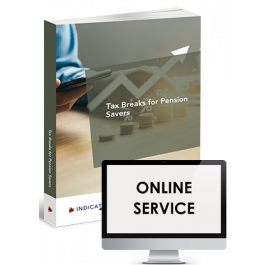Tax Breaks for Pension Savers
A Tips & Advice book about...
In a nutshell
This book is a comprehensive guide to pension saving. It covers registered pensions and the corresponding tax regime in detail incorporating all the latest Budget 2023 changes. It explains the ins and out of different pension schemes and their tax treatment and includes a raft of tax planning tips and examples for improving tax efficiency when contributing to or taking money from your pension funds.
In detail
Private pension schemes have been at the heart of saving for retirement for many years, not least because of the tax breaks they attract. They are now easy to access long before retirement while allowing you to continue building pension savings for later with all the advantages of generous tax exemptions and reliefs. This book looks in detail at the rules that govern different types of pension scheme from small self-administered schemes to personal pension plans, and of course how you can use each type of scheme to save tax. In this book you’ll find detailed guidance and advice about:
- the different types of pension scheme on the market
- which schemes work best for you
- pension planning for business owners and employers
- increasing tax saving with pension contributions
- avoiding penalty tax charges
- accessing your pension savings tax efficiently
- and much more
This book is packed with useful information and advice about how to accumulate and manage pension savings, make the most of the tax breaks and avoid the traps hidden in HMRC’s rules.
We've created this Tips & Advice book especially for...
Anyone that wants to:
- Take full advantage to the tax breaks available to pension savers
You'll get the following free extras with this Tips & Advice book...
An online service with ready-to-use documents
- To immediately apply our advice and solutions in practice
- That you can easily adapt to suit your own requirements
In this Tips & Advice book you'll read about...
Table of contents
Part 1 - The rise of pension schemes
1. Overview of pension saving and income
1.1. Tax advantages of registered schemes
1.2. Workplace pensions
1.3. Pension portability
1.4. What are the different types of pension savings arrangement
1.5. Pension glossary
2. Spring Budget 2023
2.1. Increased annual allowance (AA)
2.2. Tapered AA
2.3. Money purchase annual allowance (MPAA)
2.4. Lifetime allowance
2.5. Tax-free cash (pension commencement lump sum)
2.6. Other pension lump sums
2.7. Pensions relief relating to net pay arrangements
2.8. Scottish income tax rates
2.9. Public service pension schemes
Part 2 - Specific types of pension scheme
1. Registered schemes
1.1. Registered pensions overview
1.2. What are registered pensions?
1.3. What are the tax advantages of registered pensions?
1.4. What restrictions and limits apply?
1.5. What is the lifetime allowance (LTA)?
1.6. When can I invest in a registered pension?
1.7. How available are registered pension schemes?
1.8. Who can invest in registered pensions?
1.9. When can I access my pension savings?
1.10. How are contributions treated for tax purposes?
1.11. What’s the tax position on money in my fund?
1.12. What are the risks to my pension savings?
1.13. Why choose registered schemes?
1.14. What are the main drawbacks of registered schemes?
2. Personal pension plans
2.1. Personal pension plan overview
2.2. How can I invest?
2.3. How much can I invest?
2.4. When can I invest?
2.5. What is the availability of plans?
2.6. Who can invest?
2.7. How are contributions treated for tax purposes?
2.8. What tax rates apply to relief for pension contributions?
2.9. Death and tax
2.10. What are the returns on my investment?
2.11. How much are the pension scheme charges?
2.12. Is there a risk to my capital?
2.13. What are the pros and cons?
3. Small self-administered schemes
3.1. Small self-administered schemes (SSAS) overview
3.2. How can I invest?
3.3. How much does an SSAS cost?
3.4. What are the minimum and maximum number of scheme members?
3.5. When can I invest?
3.6. How available are SSASs?
3.7. Who can invest?
3.8. What about access to money in an SSAS?
3.9. What is an SSAS pension?
3.10. How are contributions treated for tax purposes?
3.11. What’s the tax position when an investment is terminated?
3.12. What tax rates apply?
3.13. What’s the tax position on death?
3.14. What are the returns on investment?
3.15. What’s the risk to my capital?
3.16. Example
3.17. What are the pros and cons?
4. Self-invested personal pensions
4.1. What is a SIPP?
4.2. How are SIPPs structured?
4.3. What are the differences between SIPP types?
4.4. How can I invest?
4.5. How much can I invest?
4.6. When can I invest?
4.7. How available are SIPPs?
4.8. Who can invest?
4.9. What about access to my SIPP funds?
4.10. How are contributions treated for tax purposes?
4.11. What is a SIPP pension?
4.12. Which tax rates are applicable?
4.13. What happens on death?
4.14. What are the returns on investment?
4.15. What is the risk to my capital?
4.16. Example
4.17. What are the pros and cons?
5. Group self-invested personal pensions
5.1. Group self-invested personal pensions (GSIPP) overview
5.2. How can I invest?
5.3. How much can I invest and what are the costs?
5.4. What is the availability?
5.5. Who can invest?
5.6. What about accessibility to my GSIPP funds?
5.7. How are contributions treated for tax purposes?
5.8. What is a GSIPP pension?
5.9. What tax rates apply?
5.10. What happens on death?
5.11. What are the returns on my investment?
5.12. What is the risk to my capital?
5.13. Example
5.14. What are the pros and cons?
6. Defined benefit small self-administered schemes
6.1. What is a defined benefit small self-administered scheme (DBSSAS)?
6.2. How can I invest?
6.3. Who can invest?
6.4. How can I access my pension savings?
6.5. What are minimum and maximum number of scheme members?
6.6. When can I invest?
6.7. What is the availability?
6.8. How are contributions treated for tax purposes?
6.9. What is a DBSSAS pension?
6.10. How can I see the value of my fund?
6.11. What are the returns on my investment?
6.12. What is the risk to my capital?
6.13. What are the pros and cons?
7. Qualifying recognised overseas pension schemes
7.1. Qualifying recognised overseas pension schemes (QROPS) overview
7.2. What are the regulations?
7.3. How can I invest?
7.4. How much can I invest?
7.5. When can I invest?
7.6. What is the availability?
7.7. Who can invest?
7.8. What about accessibility?
7.9. Member payment charges (MPC)
7.10. Lump sum restriction
7.11. What special tax rules apply?
7.12. How are contributions treated for tax purposes?
7.13. What penalties can apply?
7.14. What are the returns on my investment?
7.15. What is the risk to my capital?
7.16. Examples
7.17. What are the pros and cons?
8. Additional voluntary contributions plans
8.1. Overview of additional voluntary contributions (AVC)
8.2. How can I invest in an AVC or FSAVC?
8.3. When can I invest in an AVC or FSAVC?
8.4. What returns on investment do AVCs and FSAVCs offer?
8.5. How do I take benefits from an AVC or FSAVC?
8.6. How are contributions treated for tax purposes?
8.7. How are benefits from an AVC or FSAVC taxed?
8.8. Are there any special risks with AVCs or FSAVCs?
9. Annuities
9.1. Overview of annuities
9.2. How can I invest?
9.3. How much can I invest?
9.4. When can I invest?
9.5. What about access to annuity funds?
9.6. How are payments treated for tax purposes?
9.7. What returns will I get on an annuity?
9.8. What is the risk to my capital?
9.9. What are the pros and cons?
10. Pension fund drawdown
10.1. Overview of pension drawdown
10.2. Can I have more than one drawdown fund?
10.3. When can I draw down from my fund?
10.4. How are drawdown payments taxed?
11. Small pot pension payments
11.1. Overview of small pension pot payments
11.2. When can a small pot payment be taken?
11.3. What other conditions are there for small pot payments?
11.4. Why take a small pot pension instead of drawdown?
11.5. Can I take small pot payments in addition to trivial commutation payments?
11.6. How are small pot payments taxed?
12. Occupational pensions - trivial commutation
12.1. Overview of trivial commutation for occupational pensions
12.2. When can a trivial commutation payment be taken?
12.3. What conditions must be met for trivial commutation payments?
12.4. Can I take benefits as trivial commutation in addition to small pot payments?
12.5. How are trivial commutation payments taxed?
13. Uncrystallised funds pension lump sums
13.1. Overview of uncrystallised funds pension lump sum (UFPLS) payments
13.2. When can a UFPLS payment be taken?
13.3. What other conditions apply to UFPLS payments?
13.4. How do UFPLS payments differ from drawdown?
13.5. Can I take UFPLS payments from more than one pension scheme?
13.6. How are UFPLS payments taxed?
14. Workplace pensions and auto-enrolment
14.1. Overview of workplace pensions
14.2. What types of pension are workplace schemes?
14.3. What are the key features of workplace pensions?
14.4. How do workplace pensions interact with other pension arrangements?
14.5. Trouble with auto-enrolment and workplace pensions
Part 3 - Tax planning
1. Pension contribution planning
1.1. How is tax relief for pension contributions given?
1.2. What is the annual allowance (AA) and money purchase annual allowance (MPAA)?
1.3. Maximising use of the AA
1.4. Planning around the AA charge
1.5. Planning around income tax rates and allowances
1.6. Avoiding AA tapering
1.7. Personally paid versus employer pension contributions
1.8. Pension-related optional remuneration arrangements (OpRAs) and salary sacrifice
1.9. Employer pension contributions instead of dividends
1.10. Pension contributions to restore personal allowance
1.11. Contributions to reduce or prevent the high income child benefit charge (HICBC)
1.12. Funding pension scheme contributions from company profits
1.13. Using pension contributions to reduce tax on business profits
1.14. Employer pension contributions to reduce inheritance tax (IHT)
1.15. Pension contributions for others
2. Pension income planning
2.1. Tax-efficient pension income
2.2. Managed or phased pension income
2.3. Small pot pension planning
2.4. Pension tax-free cash recycling
2.5. Recycling pension income
2.6. IHT considerations when accessing pension savings using drawdown
3. Further pension-related tax breaks and issues
3.1. Pensions advice as a tax-free benefit
3.2. Using a pension fund to acquire trading premises
3.3. SIPP borrowing limitations
3.4. Borrowing from the pension fund
3.5. Pension contributions and tax-efficient golden handshakes
3.6. Unauthorised payment charges
4. Alternative retirement saving arrangements
4.1. Using a company as an alternative pension fund
4.2. Lifetime ISAs v registered pensions
Part 4 - Appendices
1. Appendix 1 - benefit crystallisation events (BCE)
2. Appendix 2 - investments for pension schemes
3. Appendix 3 - summary of registered pension limits
4. Appendix 4 - UK income tax rates and bands
5. Appendix 5 - employer pension contributions - spreading of tax deduction
6. Appendix 6 - annual allowance (AA) for final salary schemes
7. Appendix 7 - money purchase annual allowance (MPAA) triggers
8. Appendix 8 - conditions for furnished holiday lets (FHLs)
9. Appendix 9 - annual allowance (AA) charge
10. Appendix 10 - calculating the annual allowance (AA) taper
11. Appendix 11 - comparison of tax efficiency of personally paid and employer (company) paid pension contributions
12. Appendix 12 - salary sacrifice paperwork
13. Appendix 13 - pension recycling
14. Appendix 14 - tax-free cash alternative to a loan
15. Appendix 15 - tax-free cash where money purchase annual allowance (MPAA) doesn’t apply
New edition coming soon
Our editors are currently finalising a new edition of this publication.
Please contact our Customer Services department for more information and/or to pre-order the new edition now.
Click here for our contact details.


 (01233) 653500
(01233) 653500 






